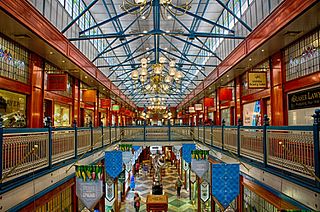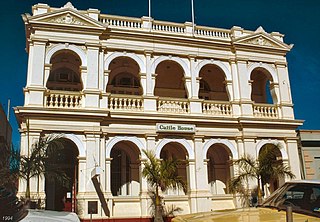
Regent Theatre was a heritage-listed cinema at 167 Queen Street, Brisbane, Australia. It was designed by Richard Gailey, Charles N Hollinshed and Aaron Bolot and built from 1928 to 1929 by J & E L Rees and A J Dickenson. It was one of the original Hoyts' Picture Palaces from the 1920s. It is also known as Regent Building. The auditorium interior was largely lost when it was converted into a 4 screen complex in 1979–1980, but the building, including the surviving entrance and main foyer, was added to the Queensland Heritage Register on 21 October 1992.

Brisbane Arcade is a heritage-listed shopping arcade at 160 Queen Street through to Adelaide Street in the Brisbane CBD, City of Brisbane, Queensland, Australia. It was designed by Richard Gailey, Junior and built in 1923 to 1924 by J & E L Rees and Forsyth & Speering. It was added to the Queensland Heritage Register on 21 October 1992.

The Bank of New South Wales Building is a heritage-listed former bank building located at 33 Queen Street, Brisbane City, City of Brisbane, Queensland, Australia. It was designed by Hall & Devereux and built from 1928 to 1930 by F J Corbett & Sons. It is also known as Westpac Bank Building. It was added to the Queensland Heritage Register on 21 October 1992.

Allgas Building is a heritage-listed commercial building at South Bank Parklands, South Brisbane, City of Brisbane, Queensland, Australia. It was built in 1885. It is also known as Caledonian House, Queensland National Bank, South Brisbane Gas & Light Co. Building and All Gas House. It was added to the Queensland Heritage Register on 21 October 1992.

MacArthur Chambers is a heritage-listed former office building at 229 Queen Street, Brisbane City, City of Brisbane, Queensland, Australia. It was designed by Francis Richard Hall and built from 1931 to 1934 by George Alexander Stronach. It was also known as the AMP Building. It was added to the Queensland Heritage Register on 21 October 1992.

National Mutual Life Building is a heritage-listed office building at 299 Queen Street, Brisbane City, City of Brisbane, Queensland, Australia. It was designed by Gibbs, Finlay & Morsby in conjunction with Thomas Blair Moncrieff Wightman and was built in 1926 by J L Green & Sons. It is also known as Metway Chambers and Custom Credit House. It was added to the Queensland Heritage Register on 21 October 1992.

National Australia Bank is a heritage-listed bank building at 308 Queen Street, Brisbane City, City of Brisbane, Queensland, Australia. It was designed by Francis Drummond Greville Stanley and built from 1881–1924 by Southall & Tracey. It is also known as Queensland National Bank. It was added to the Queensland Heritage Register on 21 October 1992.

The Bank of New South Wales is a heritage-listed former bank at 242 Mary Street, Gympie, Gympie Region, Queensland, Australia. It was designed by Richard Gailey and built from 1890 to 1891 by T. Kelly. It is also known as Widgee Shire Council Chambers, Coolooa Shire Council Chambers and Gympie Regional Council Chambers. It was added to the Queensland Heritage Register on 15 April 2011.

Royal Bank of Queensland is a heritage-listed former bank at 199 Mary Street, Gympie, Gympie Region, Queensland, Australia. It was designed by Hugo Durietz and built in 1892. It was added to the Queensland Heritage Register on 15 April 2011.

Rockhampton Courthouse is a heritage-listed courthouse at 42 East Street, Rockhampton, Rockhampton Region, Queensland, Australia. It was designed by John Hitch and built from 1950 to 1955. It is also known as District Court, Queensland Government Savings Bank, Commonwealth Bank, Magistrate's Court, Police Court, and Supreme Court. It was added to the Queensland Heritage Register on 21 October 1992.

Royal Bank of Queensland is a heritage-listed former bank at 297 Kent Street, Maryborough, Fraser Coast Region, Queensland, Australia. It was designed by Victor Emmanuel Carandini and built from 1888 to 1889. It is also known as Queensland International Heritage College and Windsor House. It was added to the Queensland Heritage Register on 21 October 1992.

Queensland National Bank is a heritage-listed former bank building at 327 Kent Street, Maryborough, Fraser Coast Region, Queensland, Australia. It was designed by Frederic Herbert Faircloth and built from 1914 to 1915 by James Treevan and N C Steffensen. It is also known as Burrum Shire Council Chambers and Woodstock House. It was added to the Queensland Heritage Register on 21 October 1992.

Commercial Bank of Sydney is a heritage-listed former bank building at 191–193 Bourbong Street, Bundaberg Central, Bundaberg, Bundaberg Region, Queensland, Australia. It was designed by George Allen Mansfield and built in 1891. It is also known as the National Australia Bank. It was added to the Queensland Heritage Register on 21 October 1992.

Cattle House is a heritage-listed former bank building at 180 Quay Street, Rockhampton, Rockhampton Region, Queensland, Australia. It was designed by Addison & Corrie and built from 1903 to 1904. It is also known as Union Bank of Australia and the Cattleman's Union building. It was added to the Queensland Heritage Register on 21 October 1992.

The Queensland National Bank Building is a heritage-listed former bank building at 186 Quay Street, Rockhampton, Rockhampton Region, Queensland, Australia. It was designed by Francis Drummond Greville Stanley and built in 1880 by Collins & Mclean. It is also known as R Rees and Sydney Jones Building. It was added to the Queensland Heritage Register on 21 October 1992.

The Royal Bank of Queensland Building is a heritage-listed former bank building at 194 Quay Street, Rockhampton, Rockhampton Region, Queensland, Australia. It was built in 1888. It is also known as Diamonds & Pearls, Rivers Restaurant, and Winchcombe Carson. It was added to the Queensland Heritage Register on 21 October 1992.

Queensland National Bank is a heritage-listed former bank at 295-303 Flinders Street, Townsville CBD, City of Townsville, Queensland, Australia. It was designed by Francis Drummond Greville Stanley and built from 1878-1879 by C A Ward. It was added to the Queensland Heritage Register on 28 January 1994.

The Australian Mutual Provident Society Building is a heritage-listed office building at 416-418 Flinders Street, Townsville CBD, City of Townsville, Queensland, Australia. It was designed by Hall and Cook and built from 1937 to 1938 by Stuart Brothers. It is also known as the former AMP Building and Connolly Suthers Lawyers. It was added to the Queensland Heritage Register on 1 August 2005.

National Bank of Australasia Building is a heritage-listed former bank at 11 Mill Street, Mossman, Shire of Douglas, Queensland, Australia. It was designed by Lange Leopold Powell and built from 1935 to 1936 by Arthur E Zillfleisch and Tom Booth. It was added to the Queensland Heritage Register on 6 August 2010.

Ferrari Estates Building is a heritage-listed former bank building at 126 Charlotte Street, Cooktown, Shire of Cook, Queensland, Australia. It was designed by Eyre & Munro and built from 1890 to 1891 by John Armstrong. It is also known as Bank of North Queensland. It was added to the Queensland Heritage Register on 21 October 1992.
























